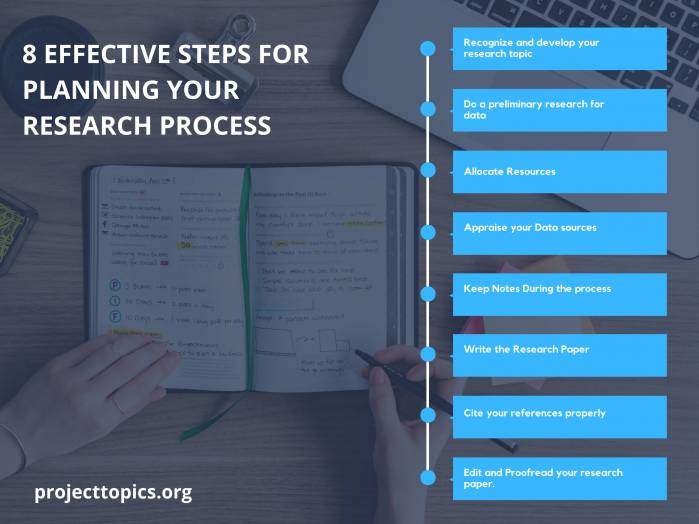8 Effective Steps for Planning your Research Process
What is a Research?
Research by definition is a process. It is the systematic inquiry that involves;
- the collection of data;
- documentation of vital information, and
- analysis and interpretation of that said data and/or information
- following given guidelines and suitable methodologies specified by a professional body or academic discipline.
Research is carried to appraise the validity of a system or an interpretive structure; to construct a body of substantive information and conclusions for sharing them inapplicable methods, and to produce questions for additional inquiries.
The subsequent steps describe a simplistic and efficient approach for carrying research and subsequently documenting it as a research paper.
Depending on your experience with the topic and the difficulties you confront along the way, you may need to adjust some of these steps.

Step 1: Recognize and develop your research topic
Choosing a topic can be the most difficult element of a research assignment. As this is the very first step in documenting your research, it is vital that it is done precisely.
Here are a couple of suggestions for choosing a topic:
- Choose a topic within the confines of the assignment. Many times your lecturer will give you clear guidelines as to what you can and cannot research about. Your refusal or inability to work within these guidelines will result in your proposed research being considered unacceptable by your lecturer.
- Choose a topic you’re personally curious about and want to learn more about. Your research process and documentation afterward will be more delightful if you are researching a topic that you find fascinating.
- Choose a topic that you can obtain a considerable amount of data for. Conduct preliminary research of data sources to ascertain whether there are existing sources which meet your needs. If you discover too much information, you may need to narrow your topic; if you find too little, you may need to broaden your topic.
- Be authentic. Your lecturer reads hundreds of research papers every year, and many of them are on the related topics (topics in the news at the time, provocative issues, subjects for which it is easy to discover data). Stand out from your classmates by choosing an unusual and unconventional topic.
Still can’t come up with a topic to research about? See your lecturer for guidance.
Once you have identified your topic, it helps to phrase it as a question.
For example, if you are interested in research about the epidemic of obesity in the Nigerian population, you might pose the question
“What are the causes of obesity in Nigeria?”
By posing your topic as a question you can more easily identify the main theories or key aspects to be used in your research.
Step 2: Do a preliminary research for data
Yes, we touched on this earlier. But let’s emphasize it. Ere starting your research in earnest, conduct a preliminary research to determine whether there is sufficient data out there for your demands and to set the context of your research. Look up your key aspects and keywords in the relevant titles in the Reference collection databases (such as Wikipedia and dictionaries) and in other sources such as our catalog of books, periodical databases, and Internet search engines.
Additional background data may be found in your lecture notes, textbooks, and reserve readings. You may find it imperative to adjust the focus of your research in light of the resources accessible by you.
Step 3: Allocate Resources
After determining the direction of your research. You should then start finding resource materials on your topic. There are a number of places you can look for data:
If you are in search of relevant books, do a topic search in the Aleph Catalog. A Keyword search can be done if the topic search doesn’t yield sufficient data. Print or write down the citation information (author, title, etc.) and the location (call number and collection) of the item(s). Note the circulation status.
Use your school’s library automated periodical databases to find magazine and newspaper articles. Choose the databases and formats that best suits the particular topic; you can also ask at the librarian at the Reference Desk if you need help deciding out which database best meets your needs. Most of the articles in the databases are available in full-text format.
Of course, utilize search engines (Google, Google Scholar, Yahoo, etc.) and subject directories to find resource materials on the web for your research.
PS: Check the Internet Resources section of the NHCC Library web site for helpful topic links.
Step 4: Appraise your Data sources
Your lecturer expects that you will present credible, accurate, and reliable data and you have every right to expect that the sources you use are presenting the same. This step is extraordinarily important when using Internet resources, many of which are viewed as less than credible.
Check the CARS Checklist for Information Quality for tips on evaluating the authority and quality of the information you have utilized.
Step 5: Keep Notes During the process
While conducting your research it’s important to keep notes and specific findings that will help you when writing the research report or research paper.
Refer to the resources you have chosen and note the information that will be useful in your paper. Be sure to document all the sources you consult, even if there is a chance you may not use that particular source. The author, title, publisher, URL, and other data will be required later when formulating a catalog.
Step 6: Write the Research Paper
Start Off by organizing the data you have collected during the research process.
First off write out a rough draft of the research paper, Here you will write out your raw ideas on paper in an incomplete form. This will help you organize your ideas and give a preliminary structure for the larger research paper. After this, you will revise the draft as many times as you deem necessary to develop a final outcome to submit your lecturer.
Step 7: Cite your references properly
Citing and/or documenting your sources utilized in your research serves two purposes: it gives fitting credit to the authors of the resource materials utilized, and it allows those who are reading your work to reproduce your research and discover the sources that you have listed as references. The Harvard, MLA and the APA Styles are three most popular citation formats.
The failure, or inability to cite your references properly is plagiarism.
Hence Plagiarism can be avoidable!

Step 8: Edit and Proofread your research paper
This is the final step when writing a research paper and you will repeat this process several times. Well, that’s if you want to get a good score. I’ll assume you do.
Editing is part of the revision process as well, but try not to get bogged down with correct spelling and sentence structure until the very end. The logic of your argument is more important than what comma goes where.
After the initial proofreading and editing, it’s time to proofread once again, this time be on the lookout for:
- Repetitions
- Incomplete sentences
- Dangling modifiers
- Easily confused words (such as to, too, and two)
- Spelling mistakes
- Apostrophes for possessives and plurals
- Quotation rules obeyed
- Comma use
- Contractions.
Done? Awesome!
Next, it’s time to give it to a professional proofreader, friend or family to proofread one more time. You don’t have to take their opinions but seeing the research paper from their eyes will allow you to know if the intended message was properly communicated.
If you like this article, see others like it: